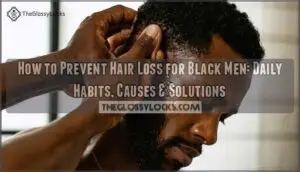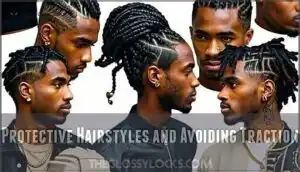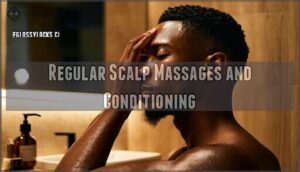This site is supported by our readers. We may earn a commission, at no cost to you, if you purchase through links.

These signs often stem from unique challenges, including tight hairstyles that pull at follicles, specific scalp conditions more common in textured hair, and genetic factors that interact differently with our hair structure.
Understanding how to prevent hair loss for Black men means recognizing these patterns early and building habits that protect your hair before damage becomes permanent. The good news is that prevention works better than treatment, and simple changes to your daily routine can keep your hairline intact for years to come.
Table Of Contents
- Key Takeaways
- What Causes Hair Loss in Black Men?
- Early Signs of Hair Loss to Watch For
- Daily Habits to Prevent Hair Loss
- Healthy Lifestyle Tips for Hair Growth
- Proven Treatments and Restoration Options
- Frequently Asked Questions (FAQs)
- Is hair loss reversible?
- What are the long-term effects of hair loss?
- Is there any way to prevent hair loss?
- Are there any natural remedies for hair loss?
- Is it possible to regrow hair on a receding hairline?
- Can hair loss be completely reversed naturally?
- How long before treatments show visible results?
- Does wearing hats or durags cause baldness?
- Are hair loss supplements worth the cost?
- Can switching barbers prevent future hair loss?
- Conclusion
Key Takeaways
- Hair loss in Black men often starts with subtle warning signs like traction alopecia from tight hairstyles, scalp tenderness, or widening temples—catching these early through daily observation makes prevention far more effective than waiting for visible thinning to appear.
- Protective styling choices matter more than genetics alone: avoiding excessive tension from braids, reducing heat and chemical exposure, and switching hairstyles every two weeks can prevent permanent follicle damage that leads to irreversible baldness.
- A balanced diet rich in protein, iron, zinc, and vitamins D and B12 directly supports hair follicle health, with clinical studies showing 83.7% of men experience improved hair density after six months of proper nutrition combined with stress management and adequate sleep.
- Evidence-based treatments like minoxidil (74% effectiveness in four months) and finasteride (86% maintain growth at ten years) work best when started early and used consistently, while emerging options like PRP therapy and low-level laser treatment show 60-90% success rates for men seeking non-surgical restoration.
What Causes Hair Loss in Black Men?
Hair loss can show up for a lot of different reasons, and it’s not always easy to spot what’s behind it. From everyday routines to underlying health factors, there’s a lot that can play a part.
Let’s break down the usual suspects.
Genetic and Hormonal Factors (Androgenic Alopecia, DHT, Testosterone)
Although you might inherit more than your smile from your parents, male pattern baldness in Black men is especially tied to genetic and hormonal factors. DHT sensitivity and specific genetic polymorphisms set the stage for hair loss, while ancestry differences impact how and when it appears. Traction alopecia can also weaken hair follicles.
Look for:
- Heritability estimates
- Hormonal influence
- Androgenetic alopecia signs
- Dihydrotestosterone’s effects
- Patterns unique to Black men
Traction Alopecia and Hair Styling Practices
If you’ve ever felt a little too much tug when undoing your braids or noticed breakage after tight styles, you’re not alone—certain everyday hair practices can quietly pull at your roots and set the stage for traction alopecia.
Tight hairstyles, frequent wig application, and weave damage all strain follicles.
For Black men, gentle protective styles and scalp health are key for better hair care and less hair loss.
Scalp Conditions (Folliculitis, CCCA, Telogen Effluvium)
When it comes to hair loss in Black men, stubborn scalp conditions often fly under the radar as the real problem.
Take Folliculitis Keloidalis—those painful bumps and scars don’t just hurt, they can damage hair follicles for good. Or CCCA (Central Centrifugal Cicatricial Alopecia), which doctors sometimes miss because it’s so hard to pin down.
Then there’s telogen effluvium, where stress triggers sudden shedding and leaves you dealing with inflammation and treatment hurdles that are specific to Hair Care for Black Men.
Treatment options can include topical minoxidil solutions to stimulate hair growth.
Diet, Stress, and Lifestyle Influences
While scalp conditions can sneak up on you, what you eat, how you manage stress, and those everyday choices you make play a bigger role in hair health than most folks realize.
Poor Dietary Impact—missing vitamins and minerals—can speed up hair loss.
Prioritizing Sleep Quality, regular exercise, hydration, and good Stress Management helps Black men stay a step ahead in Hair Loss Prevention.
Chemical and Mechanical Hair Damage
Even when you think your hair care routine is safe, the wrong products or rough styling habits can quietly chip away at healthy growth. Chemical relaxers, tight braids, frequent heat styling, and weave damage each raise your risk of traction alopecia and hair breakage.
Product buildup clogs follicles, making hair loss prevention essential for Black men focused on trusted African American hair care.
Early Signs of Hair Loss to Watch For
Spotting the first signs of hair loss can help you take action sooner rather than later.
A few telltale changes tend to show up first. Let’s look at the specific signs.
Receding Hairline and Thinning Hair
Noticing your hairline creeping back or your afro looking a little thinner than usual can feel like your hair’s sending you a subtle SOS. These early shifts—fading corners, less density, shorter styles—are a heads-up for Black men:
- Patterns changing? Don’t wait to act.
- Early intervention helps keep options open.
- Small choices mean big wins for density maintenance.
Scalp Itching, Redness, and Inflammation
If your head ever feels tender, prickly, or a little too warm, your scalp could be trying to tell you there’s more going on under the surface.
Inflammation triggers, like chronic conditions or a disrupted scalp microbiome, can lead to hair loss.
Identifying allergens and reaching for soothing remedies helps keep scalp health a priority for Black men.
Sudden or Patchy Hair Loss
It’s a real gut-check moment when you discover a bald spot or realize a chunk of hair has fallen out almost overnight.
For Black men, sudden or patchy hair loss might point to Alopecia Areata, Scarring Alopecia, fungal infections, or autoimmune disorders. Finding out what’s behind it matters—and fast.
These conditions can escalate quickly, so acting early gives you the best shot at keeping the hair you have.
When to Seek Professional Diagnosis
How do you know when it’s time to trade home remedies for a doctor’s advice? If early symptom recognition suggests hair loss is more than just shedding—say, unexplained scalp conditions or sudden thinning—it’s wise to see a specialist.
Screening for underlying conditions, biopsy necessity, or blood test insights can reveal hidden causes. A timely trichology clinic visit gives Black men real answers.
Daily Habits to Prevent Hair Loss
Even small changes to your daily routine can go a long way for your hair’s health.
The way you care for your hair each day has more impact than you might realize.
Here are a few straightforward habits that can make a real difference in keeping your hair healthy and growing strong.
Choosing Gentle Hair Care Products
Ever wondered why your hair feels softer and looks healthier after switching to kinder shampoos and conditioners? It’s not just luck—choosing gentle hair care products is key for Black men’s hair loss prevention. Here are five tips:
- Opt for sulfate-free shampoos.
- Use moisturizing conditioners.
- Favor natural ingredients.
- Check product pH levels.
- Practice gentle detangling.
Protective Hairstyles and Avoiding Traction
When your hair feels its best thanks to gentle products, the next smart move is to make sure your style is helping, not hurting.
Pick protective hairstyles that keep tension off your roots. Set Hairstyle Tension Limits, avoid tight braids, switch up styles every two weeks, practice wig cap hygiene, and use edge protection methods to limit breakage and traction alopecia.
Regular Scalp Massages and Conditioning
Healthy roots don’t just depend on the right hairstyles—they also benefit from a bit of regular TLC, like soothing scalp massages and deep conditioning.
Working a nourishing oil into your scalp boosts circulation and moisture, making hair feel softer and stronger.
Try DIY recipes or gentle product application as practical hair care tips for Black men looking to strengthen scalp health and prevent hair loss.
Reducing Heat and Chemical Exposure
Just as a gentle touch works wonders for your scalp, staying mindful about heat tools and harsh chemicals keeps your hair thriving longer.
Frequent heat styling damage and chemical relaxers break down hair’s structure, making it more fragile. Use chemical relaxer alternatives, gentle coloring methods, and always reach for protective product barriers and hydration after treatments—your best defense for hair loss prevention.
Healthy Lifestyle Tips for Hair Growth
Healthy hair starts with the choices you make every day. Simple habits go a long way toward supporting strong growth and minimizing breakage.
If you want your hair to look and feel its best, here’s what matters most.
Balanced Diet Rich in Protein, Vitamins, and Minerals
Think of your diet as the foundation for preventing hair loss—without the right fuel, your follicles can’t produce strong, healthy hair. Black men facing hair loss prevention need to prioritize:
- Protein Sources like eggs, fish, poultry, beans, and lentils—since protein makes up 95% of your hair shaft structure
- Vitamin D and B12 to support follicle cycling and prevent chronic shedding common in vitamin deficiencies
- Iron and zinc from lean meats, nuts, and leafy greens to strengthen follicles and prevent mineral imbalance
- Biotin and Vitamin C for keratin production and better iron absorption
- Antioxidant-rich dietary patterns that reduce inflammation linked to androgenic alopecia
Clinical outcomes show that balanced vitamins and minerals intake improves hair density in 83.7% of men, including African Americans, after six months—making nutrition a cornerstone of any healthy lifestyle approach.
Regular Exercise and Stress Reduction
Physical activity doesn’t just build muscle or burn calories—it directly strengthens the network of blood vessels feeding your hair follicles, while chronic stress quietly triggers hormonal shifts that accelerate shedding.
For Black men facing hair loss, exercise benefits extend beyond scalp circulation—regular movement lowers stress hormones like cortisol that disrupt your hair growth cycle.
Pairing 30-minute workouts with stress-relief techniques like meditation or deep breathing not only boosts your mood, but also sets up the healthiest hormonal balance to help protect against hair loss.
Adequate Sleep and Hydration
While you’re catching those extra minutes of sleep each night, your body quietly shifts into repair mode—rebuilding hair follicles and balancing the hormones that either fuel growth or trigger shedding. Sleep quality directly impacts cellular repair processes critical for hair loss prevention in Black men.
Pair this with proper water intake—adequate hydration benefits your scalp by maintaining moisture levels and flushing toxins that compromise healthy hair growth. Think of scalp hydration as the foundation for a healthy lifestyle that bolsters your follicles from the inside out.
Avoiding Harmful Medications and Medical Treatments
Some prescriptions you’re taking for other conditions might be quietly working against your hair—medications like blood thinners, beta-blockers, and even certain antidepressants can trigger unexpected shedding.
This drug-induced alopecia affects Black men differently, sometimes accelerating baldness alongside genetic factors.
Talk to your doctor about medication alternatives before stopping anything, and be cautious with steroid risks, chemotherapy effects, or radiation therapy that can disrupt follicle health.
Exploring nonsurgical hair restoration options early gives you more control over treatment outcomes.
Proven Treatments and Restoration Options
If prevention hasn’t done the trick, don’t worry—there are plenty of medical and cosmetic treatments that can help regrow hair or slow down any further loss.
From FDA-approved medications to advanced surgical methods, each solution is tailored to work differently depending on the type of hair loss you’re experiencing.
Here’s a closer look at your options and what each one has to offer.
Minoxidil, Finasteride, and Natural Serums
You’ll find that Minoxidil and Finasteride are your strongest scientifically-backed options for Male Pattern Baldness in Black Men. Studies show that combined oral therapy keeps 92% of men stable or improving after a year. Here’s what works:
- Minoxidil efficacy: A 5% solution increases hair density in 74% of men within four months
- Finasteride safety: Long-term use maintains hair growth in 86% of men at ten years, though sexual side effects require discussion
- Serum ingredients: Plant-based options like MDhair Restore Serum with saw palmetto and pumpkin seed oil show promise, reducing Hair Loss by up to 90%
Adherence strategies matter—consistency determines success with any treatment.
Platelet-Rich Plasma (PRP) and Laser Therapy
PRP therapy and low-level laser therapy represent emerging, non-surgical options showing real promise for Black men experiencing hair loss. Studies confirm that 60-70% of patients see measurable hair density improvements with PRP, while laser therapy boasts success rates exceeding 90% when used consistently.
Here’s how they compare:
| Treatment Aspect | PRP Therapy | Laser Therapy |
|---|---|---|
| Efficacy | 15-30% hair count increase over 3-4 months | 19.8-67.2 hairs/cm² improvement in 16-26 weeks |
| Best For | Localized thinning areas | Diffuse, widespread hair loss |
| Safety Profile | Safe for Black men; mild discomfort during procedure | Safe across all skin tones; minimal side effects |
| Treatment Costs | $500-$1,500 per session | One-time device purchase ($200-$3,000) |
| Maintenance Sessions | Every 6-12 months | Daily at-home use (15-30 minutes) |
When you combine both treatments, the results are even more impressive—about 80% of people see benefits from using them together.
Both approaches are easy to tolerate, and clinical studies haven’t found any lasting side effects.
Hair Transplant Surgery
If you’re looking for a more permanent solution than daily treatments, hair transplant surgery relocates healthy follicles from one part of your scalp to areas experiencing thinning or baldness.
Two main surgical techniques—FUT and FUE—differ in graft survival rates and scarring outcomes. Procedure costs generally range from $4,000 to $15,000, with recovery timelines spanning 10-14 days before you return to normal activities.
Success depends on proper technique suited to your hair texture.
Scalp Micropigmentation and Cosmetic Solutions
Not every solution requires surgery—scalp micropigmentation uses cosmetic tattooing to create the appearance of fuller hair by reducing the contrast between your scalp and existing strands. This technique works especially well for Black men because it mimics natural hair density without ongoing medication.
- SMP techniques deposit tiny pigment dots that replicate individual hair follicles
- Scar coverage conceals transplant scars or patches from previous hair loss
- Maintenance costs range from $100-$300 annually for touch-ups to preserve the density illusion
Frequently Asked Questions (FAQs)
Is hair loss reversible?
Hair loss reversibility depends on the underlying cause and damage severity. Lifestyle changes and hair loss prevention efforts can play a significant role in promoting hair regrowth in black men, especially when follicles remain intact.
Hair loss treatment options, such as minoxidil, can also support regrowth, though treatment timelines vary by individual.
What are the long-term effects of hair loss?
Hair Loss can quietly reshape your world beyond the mirror. For Black Men facing Male Pattern Baldness or Hair Thinning, the long-term effects often ripple through mental health, self-esteem impact, relationship dynamics, social isolation, and even career prospects—making early action imperative.
Hair loss in Black men can deeply impact self-esteem, relationships, and mental health, making early action more important than ever
Is there any way to prevent hair loss?
Yes—early intervention and preventative measures work. Lifestyle adjustments, smart product selection, and consistent routines can slow or stop hair loss in Black men.
Addressing causes of hair loss early offers the best chance at baldness prevention.
Are there any natural remedies for hair loss?
Natural options like saw palmetto, essential oils, and scalp massages can support hair growth in Black men. Dietary changes rich in vitamins and minerals strengthen follicles, while herbal supplements offer comprehensive approaches to scalp health.
Is it possible to regrow hair on a receding hairline?
Regrowing hair on a receding hairline is possible with treatments like minoxidil and finasteride, though results vary.
These medications work best when started early and require consistent, long-term use to maintain hair regrowth and prevent further Male Pattern Baldness progression.
Can hair loss be completely reversed naturally?
Reversing hair loss naturally sounds like finding a fountain of youth in your medicine cabinet. Natural Reversal Feasibility depends heavily on the cause.
Eating well and making healthy lifestyle changes can help restore your scalp’s condition, but when it comes to natural remedies for Black men with permanent genetic hair loss, results tend to vary quite a bit.
How long before treatments show visible results?
How quickly you’ll see hair growth can depend on your unique situation, but the real key is sticking to your routine.
Male Pattern Baldness treatments generally show visible results in three to six months for Black men, though some notice changes earlier.
Setting realistic goals and having a clear sense of what to expect can really help you stick with your chosen routine.
Does wearing hats or durags cause baldness?
Wearing hats or durags doesn’t directly cause Male Pattern Baldness or permanent Hair Loss. However, tightness matters—excessive hairline pressure from tight-fitting headwear can contribute to traction-related Hair Thinning over time.
Wearing duration and hat hygiene also play roles; dirty durag materials may irritate your scalp, potentially affecting Hair Loss Prevention efforts.
Are hair loss supplements worth the cost?
Supplement efficacy varies widely based on ingredient quality and dosage concerns. Vitamins and minerals like biotin and saw palmetto may support hair growth promotion methods.
However, cost comparison reveals that quality products yield better long-term effects for hair loss prevention.
Can switching barbers prevent future hair loss?
Switching barbers won’t directly prevent hair loss, but choosing one skilled in clipper hygiene and hairline maintenance matters.
Poor barbering techniques—like aggressive clipper work or styles causing traction alopecia—can damage follicles over time.
A knowledgeable barber recommends style suitability for your hair type and scalp health.
Conclusion
Your hairline is like a garden—neglect it, and you’ll watch it thin out; tend to it daily, and it thrives. Learning how to prevent hair loss for black men means treating your scalp and strands with intention, not as an afterthought.
The techniques you’ve read aren’t complicated, but they require consistency. Loose styles, gentle products, balanced nutrition, and early intervention turn prevention from theory into practice.
Your hair can last a lifetime if you protect it now, before damage writes a story you can’t rewrite.
- https://pmc.ncbi.nlm.nih.gov/articles/PMC9511210/
- https://www.sciencedirect.com/science/article/pii/S2352512623001765
- https://www.mdhair.co/article/black-men-and-hair-loss-finding-the-right-treatment
- https://www.ncbi.nlm.nih.gov/books/NBK278957/
- https://academic.oup.com/biomedgerontology/article/60/8/1077/545174










